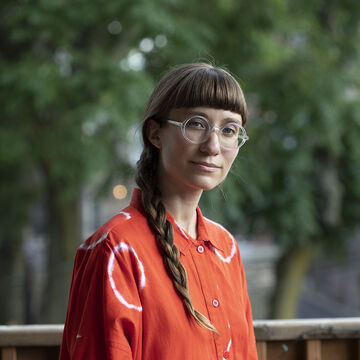

Kayla Anderson
Lecturer
Contact
Bio
Kayla Anderson is an itinerant artist, writer, gardener, and organizer. Their work often investigates the ways that culture and subjectivity shape, and are shaped by, technology and more-than-human encounters. Growing up in (San Antonio) Texas, where capitalism and disenfranchisement are more relentless than the sun, they value art as an arena for non-strategic modes of thinking, feeling, and communing with others.
Education: BFA + BA in Visual and Critical Studies, 2014, SAIC; MFA, 2020, Northwestern University.
Exhibitions: Comfort Station, Nightingale Cinema, Roman Susan, Hyde Park Art Center, <3 etc., Chicago; Center for Contemporary Photography, Detroit; Urban Institute for Contemporary Art, Grand Rapids; The Chapter House, Los Angeles; HTMLles Festival, Montreal; Haus der Kulturen der Welt, Berlin; Australian Centre for the Moving Image, Melbourne; MELT Festival, Brisbane; Nhà Sàn Collective, Hanoi.
Publications: “Joiri Minaya unravels social fabrics and draws attention to patterns,” and “Morehshin Allahyari re-figures histories and imagines new futures,” Art21: In the Studio; “Floral Facades,” Association Internationale des Critiques d’Art Magazine; Old Future’s Almanac (book), Flatland; “Mounting the Horizon,” Collaborative Center for Storm Space and Seismic Research; “In Search of a Recuperative Aesthetics,” Art & Education Classroom; “Learning to Live Together,” Temporary Art Review + New Constitutions (book), Academy of Art & Design, Basel; “Twelve Books, One Long Zoom,” Aperture Magazine; “Holding Up the Sky: Art-Science Approaches to an Aero-dialogue,” Kunstlicht Journal, University of Amsterdam; “Future Reliquaries: Outposts,” The 3D Additivist Cookbook (book); "Ethics, Ecology, and the Future: Art and Design Face the Anthropocene" Leonardo Journal + MU TXT, Eindhoven; "Animism: Curating Discourse," Royal College of Art, International Awards in Art Criticism Compendium; “Object Intermediaries: How New Media Artists Translate the Language of Things” Leonardo Journal.
Awards: Onion City Experimental Film Festival ‘Best in Show’; American Austrian Foundation, Seebacher Prize for Fine Arts; Thoma Art Foundation Envision Grant; Haus der Kulturen der Welt Travel Grant; DCASE Independent Artist Program Grant; Luminarts Cultural Foundation Fellowship; Andy Warhol Foundation Writers Workshop Fellowship; Leadership, Equity, and Action for our Food System Fellowship.
Kayla also teaches art and gardening at a CPS high school on the west side of chicago where they live.